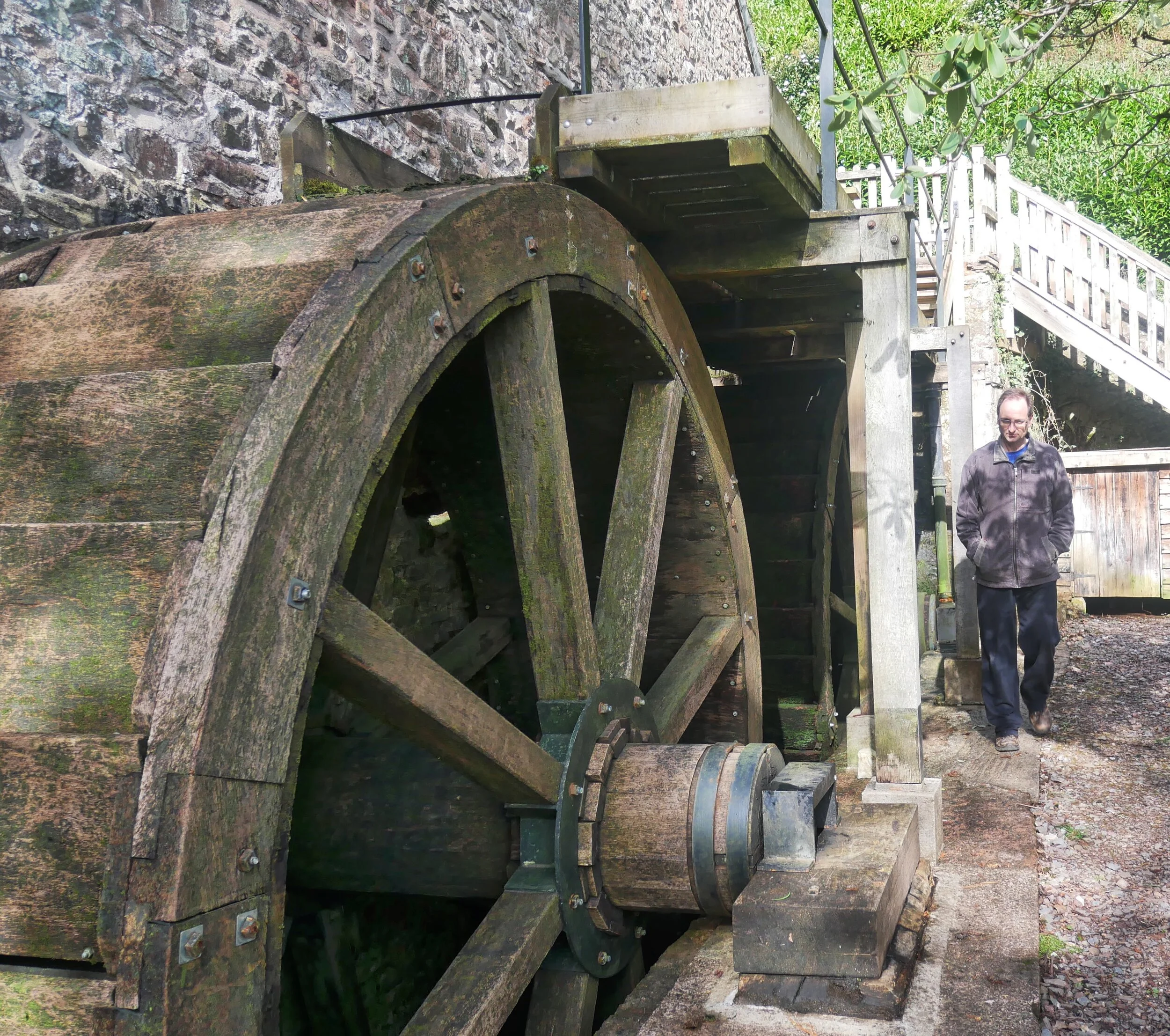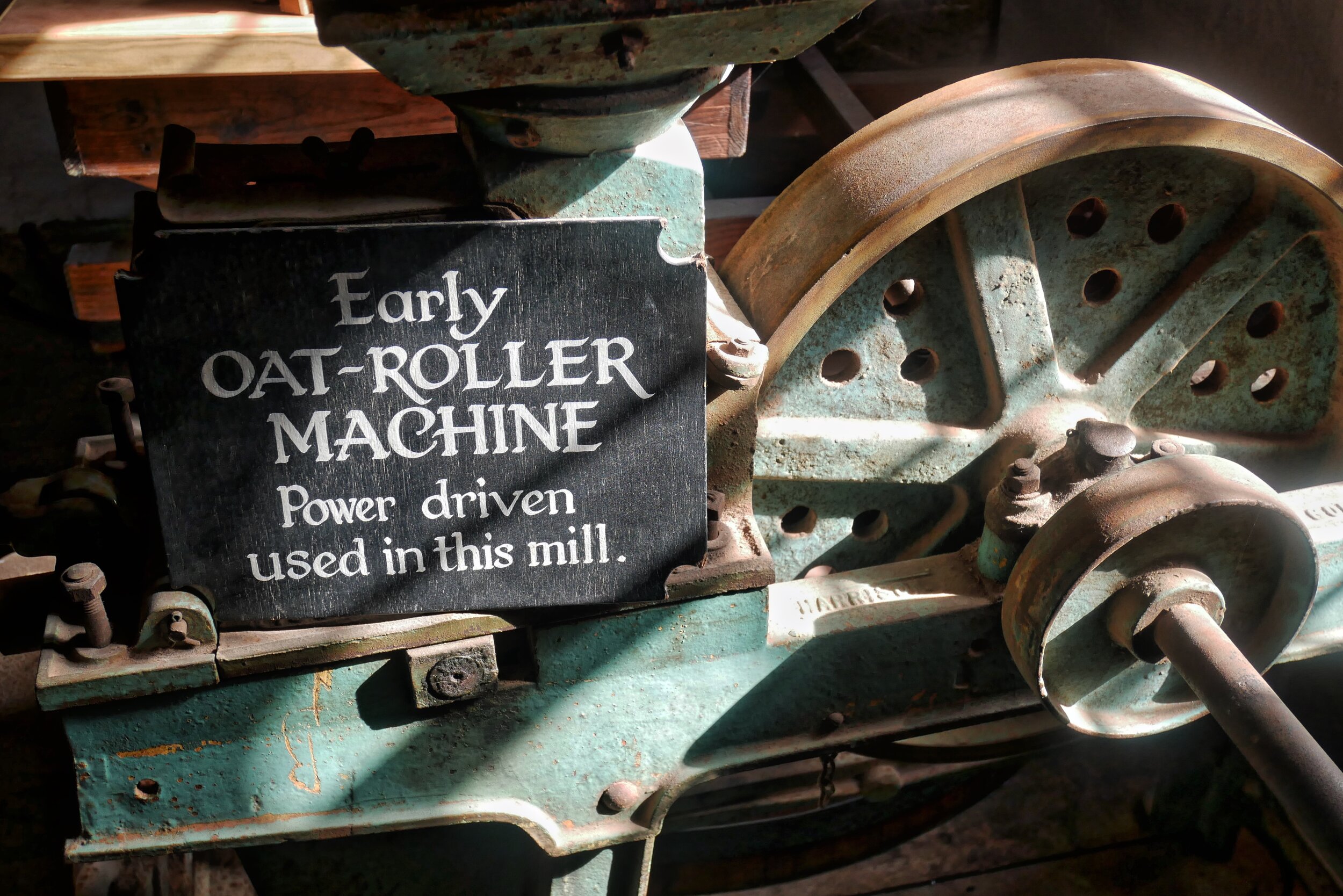Dunster's Water Powered Mill
Looking back over all the hundreds of food and drink related articles I’ve written down the years I reckon a lot of them will still be very interesting to a winder public - so I’ going to put a few up here on the website - starting with this piece I penned about the National Trust’s amazing water-powered flour mill at Dunster.
The mill is closed now during the pandemic - but it is a fascinating place to visit and they make really very good flour - so do try to visit once the world is opened up again…
Check out any corner of the food or drink scene nowadays and you will find people looking for authenticity. They want the genuine thing - whether it’s single-estate extra virgin olive oil, unpasteurised cheese made from cows fed on grass-rich pasture or bottle-fermented West Country cider.
So why not take that all the way back to one of the most basic foodstuffs of them all? Every day of our lives, most of us consume at least one thing that will contain flour - but how many of us give any thought to the actual powder that creates all that bread, pasta or pastry?
The answer is that - although it’s still a niche thing - more and more people are looking for the kind of flour that has a genuine story to tell. By which I mean: a freshly ground product that still contains plenty of essential oils and other trace elements that happen to be good for us.
And it is that trendy word “sourdough” that is pushing folk in the direction of old fashioned mills which produce flour with the help of big old grinding stones… Places where you can buy a product that is days old, rather than months or years. This is important to sourdough makers because what they are after is a fermented, ‘live’, base for their delicious bread.
What you are hoping when you make a sourdough starter is that live wild yeasts will set up house and home in your basic dough of flour and water and set about creating the fermentation process. The happier and healthier those wild yeasts are, the better your sourdough. And that is not as likely to happen if your flour has been highly processed and has had other ingredients added back into the mix.
Studies show that freshly milled flour provides added nutrients to your diet compared to flour that’s been stored for many months. Added to that, you might think you’re buying whole wheat, but that doesn’t always mean whole grain. Some milling processes perform several milling passes, especially on the germ and bran which are sifted out and then later added back in, reconstituting back to 100% of its original weight.
Once a grain of wheat has been milled, breaking open that protective bran layer, oxidisation begins which causes nutrients to degrade slowly.
And then there’s the smell and flavour of a loaf which has been made with fresh ground flour - and here I’ll quote a website called The Perfect Loaf: “Sourdough baked with freshly milled flour takes on added levels of complexity, a taste that is hard to capture in words but brings a smile to my face at each slice.
“The crust becomes incredibly thin and crackly with a forward shine to it, a shine that almost looks as if I had smeared the bread with olive oil and then baked it. The interior of my loaves is tender, light and yields a vibrant taste compared to my other loaves.”
Some aficionados, like the author of the Perfect Loaf, have contraptions which allow them to grind their own flour - but short of that, what we mere culinary mortals need is a local flour mill.
And I happen to have just that here in West Somerset, in the form of one of the most handsome working watermills in the region. I refer to the mill which is part of the National Trust property at Dunster Castle - a magical place run mainly by volunteers who have just recently started milling spelt flour to added to their famous organic whole wheat product…
It was mill manager, Stephen Hayes, who invited me to visit this week and a fascinating morning it was too..
“It’s a double-overshot wheel - and each wheel weighs three tons,” said Stephen as we began our tour at the engine-room, so to speak. “They are 12-feet in diameter and there are probably about 80 buckets in there. The two wheels are English oak - even when the Victorians transferred to cast iron for a lot of things. the wheels remained wood - and no one knows why they did that.
“They cost a lot of money - the new one here cost £30,000. They are built like a Meccano kit in Bristol - and if we keep on top of the maintenance it should last us many years.
“For probably about a thousand years this leat has been in existence,” Stephen continued. “Dunster was a cloth village or town - it used to have fulling mills. There were two watermills here in the Domesday Book. So we know the leat has been a really important part of supplying power to the mills of Dunster for a very long time.
“We produce about ten tons of wheat flour of year - but we could double or even treble that if we had three sets of working millstones. We’ve only got two at the moment - we’re looking for a third.
“For many years the mill was tenanted,” Stephen told me. “There was a separate entrance fee, but now if you’ve got your (National Trust) membership or a ticket (to the castle and grounds) you can come in for free and it makes visiting the property a much more complete experience.
“We have a team of 19 volunteers, and a full-time miller and myself. The beauty of it is - the more flour people do buy from us, the more chance there is of them seeing the mill working. The more we sell, the more we mill and make.”
Stephen and his team then took me through the basic workings as they began a day’s milling. Everything, of course, begins when the flow in the leat is redirected across the launder - the wooden shute situated above the two giant wheels.
Once they’re in motion, the shafts running through the exterior wall begin turning the various giant cogwheels inside the mill, and these in turn power vertical shafts which allow the millstones to revolve.
Just like a traditional brewery and other processing operations from days of yore everything is worked with the help of gravity. Having hoisted your raw ingredients (in this case sacks filled with wheat) to the top of the mill, various shutes take the grains down to the turning millstones, which in turn spit the fresh ground flour down yet more shuts to the floor below. This is where the quality control takes place - or the tentering, as it’s called.
“This is the tentering wheel for making fine adjustments,” explained a volunteer called Steve, showing me a small six-inch diameter control wheel. “What we do here is get a handful and you take a pinch of the flour. You see, it’s getting finer. So we make a bit more of an adjustment, give it a few seconds, and check again.”
The tentering adjusts the way in which the two millstones grind upon one another on the floor above. Too tight and the flour will be finer than talcum powder - too lose and it is rough-grained.
“It’s the original of the phrase ‘rule of thumb’,” said Steve.
“The mill wheels turn more slowly when there’s more friction,” added Stephen. “Norman, upstairs, will be trying to get more power now by opening up the sluice a bit more. So it will get faster. We will keep the quality, get the speed and have lovely flour coming out.”
Both men put on face-masks once the milling was underway and Steve told me: “Miller’s lung was a condition similar to the one coalminers suffered. If you’ve got the tentering right you will reduce the amount of dust there is around.”
“You can tell when the mill is happy. because the wheel feels right,” added Stephen. “The sounds are all right, somehow, and the flour is coming out at the speed we’re happy with. It was struggling a bit, but it’s coming along much nicer now.”
All this would have required a lot of hard work back in the day when one or maybe two men at most operated the mill.
“Bad backs and short lives,” shrugged Steve. “That is what would have happened here back in the good old days.”
“We only make what we can sell,” said Stephen as we crossed to the packing area.
“With the wholemeal - you shouldn’t keep it more than six months, because a lot of the oils - all the goodness kept within the flour - disappears. We get a lot of people who come to say our flour does make lovely bread.”
Now Dunster Mill’s new spelt flour is rapidly gaining popularity: “We get the spelt from near Glastonbury,”: said Stephen. “It is a little heavier, but it is genetically purer because modern wheats have been modified over thousands of years to get to where they are now. Whereas spelt is the original stuff where the wheat came from.
“The reason we are doing it is because we were asked,” he added, explaining that all the mill’s organic products are sold in three or 1.5 kilo packs - or there is a gift pack option that comes with yeast and recipes.
As I picked up my fresh milled bag of flour to take home, a volunteer called Marianne asked: “Why did the miller make a loaf of bread? Because he needed the dough!”
The joke must be as old as Dunster Castle. However, another joke might soon be on me… I want to have a go at making my own sourdough, which I’ve been warned is a notoriously difficult thing to do. However, one thing I won’t be able to blame, should I fail, is the flour.
TWO FLOUR RECIPES FROM DUNSTER MILL
Banana, Chocolate & Pecan Muffins
Ingredients:
2 cups Spelt Flour
3 teaspoons baking powder
1 teaspoon bicarbonate of soda
½ teaspoon salt
¾ cup caster sugar
1 egg
1 cup milk
1 teaspoon vanilla extract (optional)
2 bananas, mashed
1 cup chocolate drops / chopped chocolate – I used dark chocolate
1 cup chopped pecans
12 - 16 Muffin cases (optional)
Method:
Preheat oven to 200°C.
Line with muffin cases or grease muffin tray.
In a large bowl gently mix all the dry ingredients.
In a smaller bowl combine all the wet ingredients, including the mashed banana.
Quickly, but gently mix the liquid into the dry ingredients with a fork – expect the batter to be lumpy!
Gently add and stir in the chocolate and pecans.
Spoon / pour the batter into the muffin tray/cases.
Bake for 25 minutes, or until the mixture is set.
Cheese Straws
Ingredients:
100g Spelt Flour
Pinch of salt
Smidgeon of cayenne pepper and mustard powder
50g soft butter
50g strong cheddar cheese, grated
1 egg yolk
Cold water
Method:
Preheat oven to 200°C.
Grease a baking tray.
Mix the dry ingredients in a bowl.
Add the butter, in small pieces, and rub in to create a breadcrumb texture.
Stir in the cheese.
Add the egg yolk and enough cold water to form a stiff dough.
Roll out thinly on a floured surface and cut into straws.
Bake in the oven for 10 – 15 minutes, depending on size, until golden brown.
Remove from oven and cool slightly before removing to a cooling rack.

















